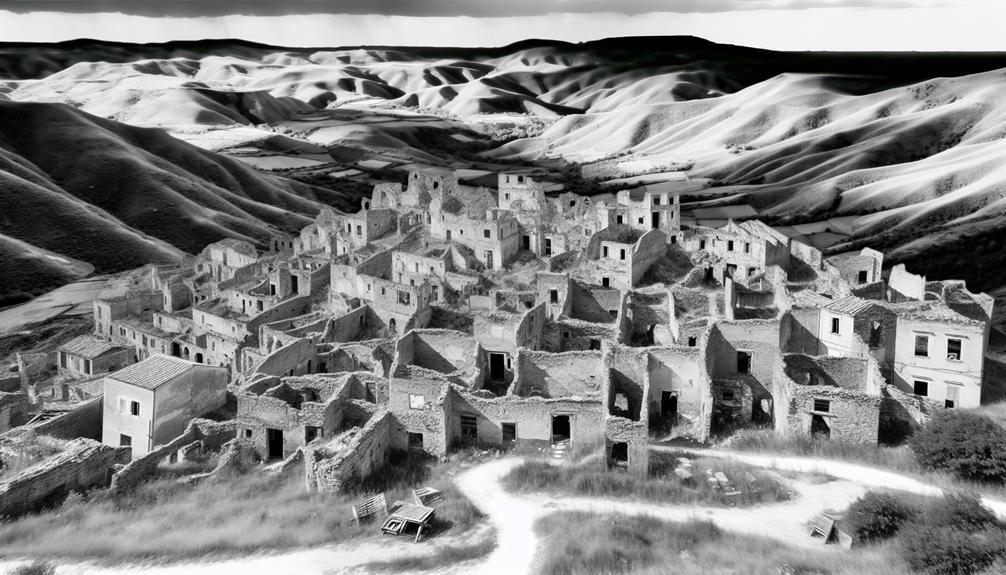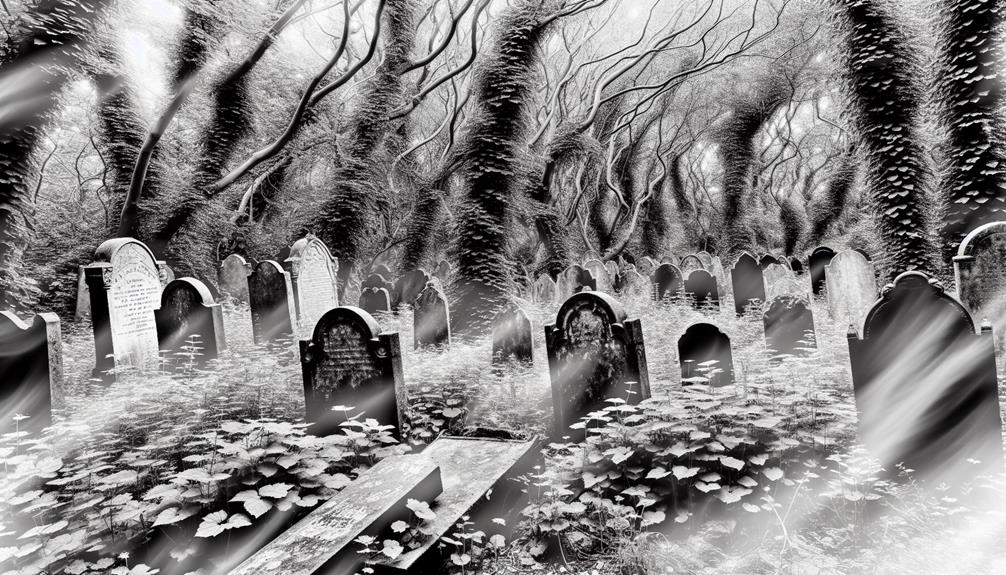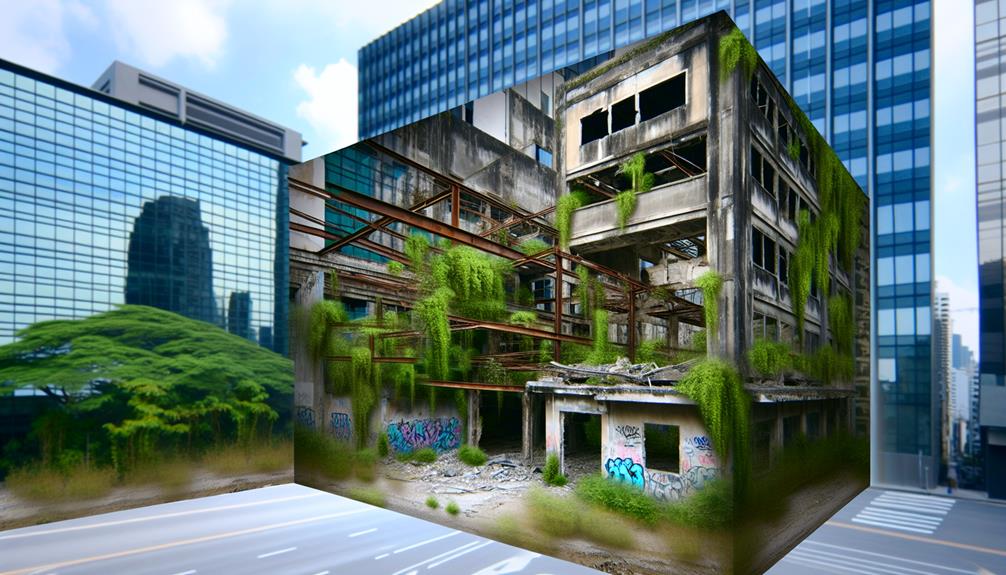Nestled atop a rugged hill in Basilicata, Italy, Craco stands as a silent witness to time's unforgiving passage. The town's crumbling facades and empty streets echo a haunting melody of a bygone era, whispering tales of prosperity turned to ruins. What secrets lie within the shadows of its abandoned walls, and what future awaits this enigmatic ghost town? The allure of Craco beckons those curious enough to explore beyond its weathered gates, prompting contemplation on the resilience of heritage in the face of nature's relentless grasp.
Key Takeaways
- Craco, Italy: Historic southern town with urban decay challenges.
- Abandonment since 1960s due to landslides and earthquakes.
- Geological forces influence layout and stability, requiring constant monitoring.
- Cultural and architectural significance through historical preservation and modern adaptations.
- Visitor experience with guided tours, preservation efforts, and sustainability initiatives.
History of Craco
Located in the southern region of Italy, the history of Craco dates back centuries, reflecting a rich tapestry of cultural influences and societal developments. Craco, a hilltop town in the Basilicata region, has faced significant challenges throughout its history, with one of the most prominent being urban decay. The town, perched on a steep summit, has witnessed a gradual decline in its population due to various factors, leading to the abandonment of many buildings and structures. This phenomenon of urban decay has posed a threat to the preservation of Craco's historic heritage.
Historic preservation efforts in Craco have been vital in maintaining the town's cultural identity and architectural legacy. The abandoned buildings, while showcasing the effects of urban decay, also serve as a poignant reminder of the town's past grandeur. Authorities and local communities have recognized the importance of preserving these historic structures, not only for their aesthetic value but also for their role in telling the story of Craco's evolution over the centuries.
Despite the challenges posed by urban decay, Craco's history remains a tribute to the resilience of its people and their commitment to preserving the town's heritage. Through ongoing efforts in historic preservation, Craco continues to stand as a symbol of the enduring spirit of its inhabitants and the rich cultural tapestry that defines this historic Italian town.
Geological Challenges Faced
The geological challenges faced by Craco, Italy, have played a significant role in shaping the town's landscape and history. The town is situated on a hill in the Basilicata region, characterized by its rugged terrain and geological formations. Erosion and landslides are two prominent challenges that have impacted Craco over the years, influencing the town's stability and development.
To understand the geological challenges faced by Craco, the following table provides a summary of key factors:
| Geological Challenge | Description | Impact |
|---|---|---|
| Erosion | Gradual wearing away of soil | Alters the landscape over time |
| Landslides | Rapid movement of rock/sediment | Destroys structures and roads |
| Geological Formations | Natural features of the land | Influence the town's layout and design |
| Stability | Ability to withstand changes | Affects the safety of inhabitants |
The geological formations in Craco, including limestone and clay, have contributed to the town's susceptibility to erosion and landslides. These challenges have necessitated constant monitoring and mitigation efforts to safeguard the safety and preservation of the town's historic buildings and infrastructure. The interplay between geological forces and human activities has shaped Craco's past and continues to impact its future.
Abandonment and Decline
Amidst the historical backdrop of geological challenges, Craco, Italy, has faced a significant shift in its narrative due to a gradual process of abandonment and decline. Once a thriving medieval town perched on a hill in the Basilicata region of southern Italy, Craco's decline began in the 1960s due to landslides and earthquakes, forcing its inhabitants to leave in search of safer living conditions.
The abandoned buildings of Craco now stand as a reflection of a bygone era, attracting urban explorers from around the world. The town's desolate streets and crumbling facades offer a haunting beauty, with nature slowly reclaiming what was once a bustling community. The eeriness of the deserted homes and churches adds to the allure of Craco, drawing visitors who are captivated by its ghostly atmosphere.
As visitors wander through the empty alleyways and dilapidated structures, they can't help but feel the weight of time and neglect that has befallen this once-vibrant town. The sense of abandonment is palpable, yet amidst the decay, there is a sense of resilience and a reminder of the impermanence of human endeavors.
Craco's journey from a prosperous medieval town to a deserted ghost town is a poignant reminder of the fragility of human settlements in the face of natural forces. Despite its decline, Craco's allure remains, beckoning travelers to witness its melancholic beauty and reflect on the passage of time.
Cultural Significance Today
Evolving beyond its physical ruins, Craco, Italy, continues to hold cultural significance today through its rich historical legacy and artistic inspiration. The town's cultural preservation efforts and modern adaptations have allowed it to maintain a sense of identity and allure in the contemporary world.
One of the key aspects contributing to Craco's cultural significance is its commitment to preserving its historical heritage. Through initiatives focused on safeguarding its past, such as museum exhibitions showcasing the town's history and traditions, Craco has been successful in keeping its cultural roots alive. In addition, events celebrating local folklore and cuisine further enhance the town's cultural vibrancy, attracting both locals and tourists alike.
Moreover, Craco has embraced modern adaptations that blend harmoniously with its historical charm. The integration of contemporary art installations within the town's ancient streets and buildings creates a unique juxtaposition that captivates visitors. Additionally, the restoration of certain structures for modern use, such as transforming old churches into cultural centers or boutique hotels, demonstrates a thoughtful approach to preserving the town's architectural heritage while adapting to present-day needs.
To evoke the emotional connection visitors may feel towards Craco's cultural tapestry, the following table highlights the town's enduring appeal:
| Historical Legacy | Artistic Inspiration | Culinary Traditions |
|---|---|---|
| Ancient ruins whisper tales of the past | Street art breathes new life into old walls | Local recipes passed down through generations |
Architectural Highlights
Steeped in centuries of architectural history, Craco, Italy boasts a tapestry of striking structural highlights that stand as evidence to its enduring legacy. The town's architectural landscape is a mesmerizing blend of Renaissance architecture and medieval ruins, offering a glimpse into its rich past.
One of the most prominent architectural features in Craco is the Palazzo Maronna, a stunning example of Renaissance architecture. This noble palace, with its intricate façade and elegant design, serves as a tribute to the town's affluent past and artistic prowess during the Renaissance period. The Palazzo Maronna stands as a symbol of Craco's cultural and historical significance, attracting visitors from around the world.
In contrast to the Renaissance elegance of the Palazzo Maronna, the medieval ruins scattered throughout Craco tell a different story. The crumbling walls, arches, and pathways of the abandoned medieval quarter evoke a sense of mystery and intrigue, transporting visitors back in time to a bygone era. These haunting ruins serve as a reminder of Craco's tumultuous history, adding a layer of depth to the town's architectural tapestry.
Visitor Experience and Tours
While exploring the architectural wonders of Craco, Italy, visitors can immerse themselves in a curated experience that reveals the town's history through guided tours and interactive encounters. Craco's visitor experience blends the allure of its ancient structures with modern amenities to offer a rich and educational journey for tourists. Here are some key elements that contribute to an unforgettable visit to Craco:
- Guided Tours: Knowledgeable guides lead visitors through the cobblestone streets, sharing enthralling stories about the town's past, its inhabitants, and the architectural evolution of the buildings.
- Interactive Exhibits: Interactive exhibits scattered throughout the town allow visitors to engage with the history of Craco in a hands-on manner, enhancing the overall learning experience.
- Cultural Workshops: Workshops focusing on local crafts, such as pottery or traditional art forms, provide visitors with a chance to immerse themselves in Craco's cultural heritage.
- Local Cuisine: Food plays a central role in the visitor experience, with opportunities to taste authentic dishes at quaint restaurants and cafes, offering a delicious insight into the region's culinary traditions.
- Evening Events: Special events and performances held in the town square or historic venues add a touch of magic to the evenings, allowing visitors to enjoy Craco in a different light.
These components combine to create a multi-faceted and engaging experience for those exploring the captivating town of Craco.
Preservation Efforts and Future
Preservation initiatives in Craco, Italy, are crucial to safeguarding the town's cultural and architectural heritage for future generations. The town faces significant preservation challenges due to its precarious location on a steep cliff, which has led to many buildings being abandoned and in a state of disrepair. However, efforts are underway to guarantee the sustainability of Craco's rich history.
To address preservation challenges, various sustainability initiatives have been implemented. One such initiative is the use of traditional building materials and techniques in restoration projects to maintain the authenticity of the town's architecture. Additionally, there have been collaborations with experts in heritage conservation to develop thorough preservation plans that balance the need for conservation with the practicalities of modern living.
Looking to the future, Craco is exploring innovative ways to fund preservation efforts, such as leveraging tourism revenue to finance restoration projects. By enhancing the visitor experience through guided tours that highlight the town's history and cultural significance, Craco aims to raise awareness about the importance of preserving its heritage.
Frequently Asked Questions
How Did the Residents of Craco Evacuate the Town During Its Abandonment?
During times of abandonment, the evacuation process involves careful planning and execution to guarantee the safety of residents. Community response plays a crucial role in organizing evacuation efforts, providing support, and coordinating resources.
Communication channels are essential for disseminating information and guiding residents through the evacuation process. Training programs, emergency drills, and designated evacuation routes contribute to the efficiency and effectiveness of evacuating residents during times of crisis.
Are There Any Legends or Folklore Associated With Craco's History?
Legends and folklore often play a significant role in shaping the cultural identity of a place, preserving historical tales and mysteries that transcend generations. These narratives are imbued with supernatural beings and carry a deep sense of cultural significance, reflecting the beliefs and values of a community.
What Types of Wildlife Can Be Found Around the Abandoned Town?
Various bird species inhabit the area surrounding the abandoned town, creating a diverse ecosystem.
Mammal sightings are not uncommon, with species such as foxes and wild boars roaming the landscape.
The presence of these animals adds to the natural charm of the region and provides opportunities for wildlife enthusiasts to observe and appreciate the fauna that has reclaimed the abandoned town.
How Has Modern Technology Impacted the Preservation Efforts in Craco?
Modern technology, particularly remote sensing, has revolutionized preservation techniques across various landscapes. Remote sensing tools like LiDAR and drones enable detailed mapping and monitoring of heritage sites, aiding in the preservation of historical structures and landscapes.
These technologies provide valuable data for conservation efforts, allowing for more informed decision-making and targeted interventions to guarantee the long-term sustainability of cultural heritage sites.
Are There Any Plans to Repopulate or Revitalize Craco in the Future?
Just as a dormant seed awaits the nourishing rain, the future plans for revitalizing a place like Craco hold the promise of new life and vibrancy.
Revitalization efforts encompass a myriad of strategies aimed at breathing energy back into the community, fostering growth, and creating a sustainable future for generations to come.
These initiatives require thoughtful planning, community engagement, and a shared vision for a brighter tomorrow.
Conclusion
To sum up, Craco, Italy stands as a testament to the enduring legacy of a once-thriving town facing geological challenges and abandonment. While some may argue that the town's desolation overshadows its cultural significance, the blend of Renaissance and medieval structures, preservation efforts, and unique visitor experiences highlight Craco's importance in history.
By exploring its architectural gems and participating in guided tours, visitors can appreciate the rich heritage of this intriguing Italian town.


